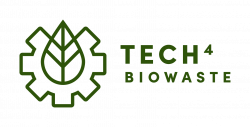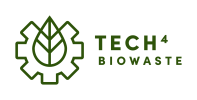Sizing
| Technology | |

| |
| Technology details | |
| Name: | Sizing |
| Category: | Pre-processing (Physical processes and technologies), Post-processing (Physical processes and technologies) |
| Feedstock: | straws, wood, wastes |
| Product: | Flowable small-sized biomass |
Sizing is a mechanical process that aims to reduce the particle size and crystallinity and to increase the specific surface area of biowaste to promote further processing of the substrate.[1] This is achieved by eliminating mass and heat transfer limitation during the required reaction. It is a very efficient technique, but a major drawback is the high energy input.[2] Moreover, sizing makes the biomass easier to handle and allows it to flow. Sizing includes chipping, extrusion, grinding, and milling as base technologies.
Feedstock
Origin and composition
Sizing is a pre-treatment technology for nearly all biowaste materials that consist of large particles like straws, wood pieces, plant fibres and other materials. It is needed to prepare smaller particles that can be processed in further steps.
Pre-treatment
Sizing is often performed as a first step in the process and requires no other pre-treatment. It is, however, not uncommon to first perform a coarse grinding before a fine grinding into smaller particles. Moreover, extrusion and milling are commonly combined with another sizing pre-treatment such as grinding.
Process and technologies
Sizing technologies normally are divided into chipping, extrusion, grinding, and milling technologies:
Chipping
For chipping normally a chipper machine is used that consists of sharp cutting knives, which cut bigger parts into smaller chips. This is used e.g. for wood materials, straws, mixed garden residues and other feedstock that can be cut by a knife. Chippers are susceptible to knife wear from high soil content, metal contamination, rocks and stone, so the base feedstock normally needs to be cleaned before chipping. The size of the resulting materials is typically 10–30 mm after chipping.
Extrusion
Extrusion is a continuous process that can handle a wide range of feedstocks, including viscous and complex fluids, and powders. The feedstock is heated and forced through an opening called 'die'. The feedstock is forced through the die by one or two screws in a heated barrel, the extruder.[3]
Grinding
There are two types of grinding: coarse grinding, which can then be followed by fine grinding. Normally a grinder is used to crack bigger parts into smaller particles. The size of the resulting materials is typically 0.2–2 mm. Grinding is achieved by shearing and/or friction and the effect is achieved by multiple comminution in an increasingly narrowing grinding gap, which can usually be varied by axial displacement of a rotor or stator. The frequently tested process variables are screen size, angular velocity, time, feed rate, type, feed size, load, moisture content, and process.[4]
Milling
Milling combines several mechanical stresses, such as compression, friction, impact, and shear. The combination of these stresses reduce the particle size, crystallinity, and degree of polymerisation, making the biowaste more accessible for further processing. However, milling is energy intensive and has a high capital cost. The required energy can be reduced by combining milling with other processes.[5]
Product
Products of sizing processes are chips, small particles or meals that can directly be used for further processing.
Post-treatment
Technology providers
| Company name | Country | Technology subcategory | Technology name | TRL | Capacity [kg/h] | Cooling system available | Feedstock: Food waste | Feedstock: Garden & park waste |
|---|---|---|---|---|---|---|---|---|
| ANDRITZ | Austria | - | Screening, separating, crushing, and sizing various biomass materials; ATEX shredders, crushers and crushing stations | - | - | ● | ||
| Mastershred GmbH | Germany | - | Mastershred | - | - | ● | ● | |
| WEIMA | Germany | - | Holzwolf | 9 | - | ● |
CENER (ES)
| General information | |||
| Company: | CENER BIO2C | ||
| Country: | Spain | ||
| Contact: | Goizeder Barberena, info@cener.com | ||
| Webpage: | https://www.bio2c.es/pretreatment-unit/ | ||
| Technology and process details | |||
| Technology name: | BIO2C – Sizing Plant | Technology category: | Pre-processing (Physical processes and technologies), Post-processing (Physical processes and technologies) |
| TRL: | 6-7 | Capacity: | o Chipper: 22 kW; capacity up to 1000 kg/h.
o Chopper: 55KW; capacity up to 3000 kg/h o Hammer mill 200-700 kg/h production capacity. Screen size 2-12 mm o Disc mill 200-700 kg/h production capacity kg·h-1 |
| Size (feedstock): | variable (up to logs, bales… ) (LxWxH) [mm] | Size (product): | variable (up to powder) (LxWxH) [mm] |
| Other: | More info: https://www.youtube.com/watch?v=qSzeXOrNTnQ | ||
| Feedstock and product details | |||
| Feedstock: | Various Biomass Materiasl: Herbaceous (cereal straw, agro-residues…), woody (pine, poplar, beech, eucalyptus, pawlonia, olive tree pruning…), variety of organic wastes (including low density materials and materials with high content of fines and dust). | Product: | Chipped, chopped and milled biomass |
CENER Biomass Department performs applied research activities in the field of biomass, providing R&D services and technical assistance to all agents of the sector. The area is focused on the development & optimization of production processes of bioproducts, solid biofuels, advanced liquid or gaseous biofuels, as well as biorefinery concepts. Indeed, the main pillars are focused on solid biofuels, bioprocesses and comprehensive sustainability assessment. The main infrastructures in this department include the Biomass Laboratory (biomass & biofuels characterization and process development at lab scale), as well as the Biorefinery and Bioenergy Centre (BIO2C).
ANDRITZ
| General information | |||
| Company: | ANDRITZ | 
| |
| Country: | Austria | ||
| Contact: | woodprocessing@andritz.com | ||
| Webpage: | https://www.andritz.com/group-en | ||
| Technology and process details | |||
| Technology name: | Screening, separating, crushing, and sizing various biomass materials; ATEX shredders, crushers and crushing stations | Technology category: | Pre-processing (Physical processes and technologies), Post-processing (Physical processes and technologies) |
| TRL: | Capacity: | kg·h-1 | |
| Size (feedstock): | (LxWxH) [mm] | Size (product): | (LxWxH) [mm] |
| Other: | |||
| Feedstock and product details | |||
| Feedstock: | Various biomass materials (e. g. stumps, wood waste, forest residuals, logs, pallets) | Product: | |
Andritz is an international technology group providing plants, systems, equipment, and services for various industries. The company is one of the technology and global market leaders in the hydropower business, the pulp and paper industry, the metal working and steel industries, and in solid/liquid separation in the municipal and industrial segments. The listed Group is headquartered in Graz, Austria. Since its foundation 170 years ago, Andritz has developed into a Group with approximately 27,400 employees, and more than 280 locations in over 40 countries worldwide.
Lignopure GmbH
| General information | |||
| Company: | Lignopure GmbH | 
| |
| Country: | Germany | ||
| Contact: | info@lignopure.de | ||
| Webpage: | https://www.lignopure.com/lignin | ||
| Technology and process details | |||
| Technology name: | Lignin downstream processing, drying, microparticle generation, application development, lab/pilot/demo scale | Technology category: | Pre-processing (Physical processes and technologies), Post-processing (Physical processes and technologies) |
| TRL: | 5-7 | Capacity: | 1 – 200 kg/day, depending on raw material and desired scale kg·h-1 |
| Size (feedstock): | Suspension (µm to mm particle size range), filter cake pieces etc. (LxWxH) [mm] | Size (product): | flexible in µm-range, depending on target application (LxWxH) [mm] |
| Other: | Processing yields fine and flowable powders, potentially reduced odour, hygienic processing possible | ||
| Feedstock and product details | |||
| Feedstock: | Lignin (Wet filter cake/suspension, dry powder, lignin-rich residues/lignocellulosic biomass, black liquor) | Product: | Lignin microparticles, powder, lignin intermediate products |
Lignopure’s years of research and experience in the field of lignin have enabled us to develop technologies and expert, project-based services for lignin producers and companies interested in making more of their lignin side streams or the utilization of tailored lignin-particles for innovative materials and applications. Our goal at Lignopure is to bring value to lignin by being the connection link between raw lignin and industries interested in novel lignin-containing applications. This is possible thanks to our extensive know-how on lignin together with Lignopure’s patented particle technology that optimizes lignin particle and powder properties without altering their multifunctional natural structure, which then enables the use of this amazing biopolymer to its fullest.
You have a lignin-rich side side stream which you want to valorize? Let us guide you through the process of developing a lignin downstream process, tailored to your raw material and the requirements of your clients, from initial lignin quality and process feasibility evaluation, via lab testing and pilot production of lignin powder prototypes up to the implementation of our technology as part of your process. Our knowhow and technology is available for licensing to crude lignin producers who want to market their raw material as a high quality, ready-to-use powder in various markets.
Mastershred GmbH
| General information | |||
| Company: | Mastershred GmbH | ||
| Country: | Germany | ||
| Contact: | Raphael Barth, Managing Director, Tel.: 07173 186-140, Email: barth(at)mastershred.de
Michael Schubert, Managing Director, Tel.: 07173 186-70, Email: schubert(at)mastershred.de | ||
| Webpage: | https://mastershred.de/ | ||
| Technology and process details | |||
| Technology name: | Mastershred | Technology category: | Pre-processing (Physical processes and technologies), Post-processing (Physical processes and technologies) |
| TRL: | Capacity: | kg·h-1 | |
| Size (feedstock): | (LxWxH) [mm] | Size (product): | (LxWxH) [mm] |
| Other: | |||
| Feedstock and product details | |||
| Feedstock: | mixed biowaste | Product: | - Bio-Liquid for methane production
- dried and pressed briquettes for bioenergy |
Mastershred offers a technology to valorize biowaste for energy supply. With a mobile compact plant in the size of a container they use novel shredding and squeezing process to produce three fractions from the biowaste:
- a bio-Liquid for methane production
- pressed material for composting, soil improvement or peat replacement
- dried and pressed briquettes for bioenergy
WEIMA
| General information | |||
| Company: | WEIMA | 
| |
| Country: | Germany | ||
| Contact: | info@weima.com | ||
| Webpage: | https://weima.com | ||
| Technology and process details | |||
| Technology name: | Holzwolf | Technology category: | Pre-processing (Physical processes and technologies), Post-processing (Physical processes and technologies) |
| TRL: | 9 | Capacity: | kg·h-1 |
| Size (feedstock): | 1875x900x1630-3375x900x1630 (LxWxH) [mm] | Size (product): | (LxWxH) [mm] |
| Other: | |||
| Feedstock and product details | |||
| Feedstock: | Wood | Product: | Wood chips |
WEIMA offers, among other things, shredders, briquette presses and packaging presses. The shredders and compactors are produced in Germany. At the sites in Ilsfeld, Abstatt (Baden-Württemberg) and Annaburg (Saxony-Anhalt), the 300-strong team builds more than 1,200 customer solutions per year on more than 44,000 m² for worldwide use.
Open access pilot and demo facility providers
Patents
Currently no patents have been identified.
References
- ↑ Quanguo Zhang, Chao He, Jingzheng Ren, Michael Goodsite, 2021: Waste to renewable biohydrogen. Volume 1, Advances in theory and experiments. Elsevier Inc., Amsterdam.
- ↑ Muhammad H. Rashid, 2015: Electric renewable energy systems. Elsevier Inc., London, UK.
- ↑ Clive Maier, 1998: Polypropylene : the definitive user's guide and databook. Plastics Design Library, Norwich, NY.
- ↑ Tumuluru JS, Heikkila DJ, 2019: Biomass Grinding Process Optimization Using Response Surface Methodology and a Hybrid Genetic Algorithm. Bioengineering, Vol. 12, (6, no. 1), 1-12. doi: https://doi.org/10.3390/bioengineering6010012
- ↑ Yalew Woldeamanuel Sitotaw, Nigus G. Habtu, Abaynesh Yihdego Gebreyohannes, Suzana P. Nunes, Tom Van Gerven, 2021-08-12: Ball milling as an important pretreatment technique in lignocellulose biorefineries: a review. Biomass Conversion and Biorefinery, Vol. , . doi: https://doi.org/10.1007/s13399-021-01800-7
